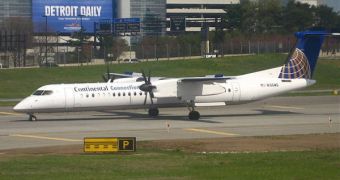On Thursday, a National Transportation Safety Board commission held another hearing, trying to make sense of the Flight 3407 disaster that struck on February 12th, 2009, in the northeast Buffalo suburb of Clarence Center, just nine kilometers away from its landing site. The panel heard a number of experts, including physicists and psychologists, in an attempt to piece together the chain of events that led to the Bombardier Dash 8 Q400-type aircraft stalling its engines and dropping out of the sky on top of a home, killing all 49 passengers and a man inside the house.
It would appear, the conclusion of the hearing shows, that the pilots were unable to keep an eye on multiple flight variables at the same time, and perhaps missed the most important one, namely the fact that ice deposits on the windshield and the wings were making the craft slow down at a low speed, unsafe for continuous flying. When the alarms finally went off, The New York Times reports, the pilots panicked and pulled on the controls, although they should have theoretically pushed the plane into a dive themselves. As a direct result, the engines on the twin-engine turboprop both stalled, and the plane simply fell from the sky.
“I don’t see any evidence that he ever understood the situation he was in. He knew something was wrong, but I don’t see that he ever said, ‘wait a minute, I’ve got to get the nose down,’” Dr. R. Key Dismukes, who is currently a researcher at the NASA-operated Ames Research Center, said of the 47-year-old pilot. Capt. Marvin D. Renslow was the lead pilot on the craft at the time of the accident. “We don’t really train pilots [for such emergencies]. We tell them they’re supposed to be vigilant, we tell them to monitor, but we haven’t developed explicit techniques,” the expert added during the third and final day of the hearings.
The pilots may have also had a hard time distinguishing if whether it was the tail of the plane that stalled, or if its wings were responsible. Procedures in either case are different from each other, and the pilot may have acted in good faith pulling on the stick, rather than pushing it. However, other factors, such as the extreme tiredness, and the stress of flying in an unfamiliar territory, may have also exerted additional strain on the two pilots, and may have sealed the faiths of the 45 passengers and the four crew members aboard in the end, as well as that of the man in his home.

 14 DAY TRIAL //
14 DAY TRIAL //